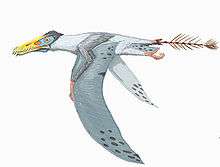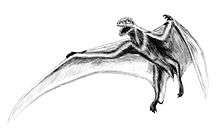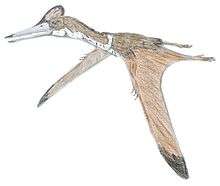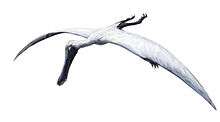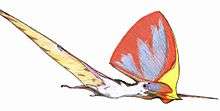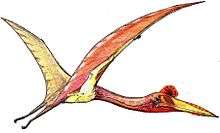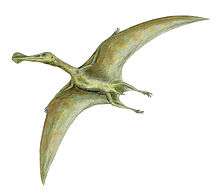Ikrandraco
Ikrandraco ("Ikran [a flying creature from Avatar with a crest on the lower jaw] dragon") is a genus of lonchodectid pterodactyloid pterosaur known from Lower Cretaceous rocks in northeastern China. It is notable for its unusual skull, which features a crest on the lower jaw.
| Ikrandraco | |
|---|---|
 | |
| Holotype, Paleozoological Museum of China | |
| Scientific classification | |
| Kingdom: | Animalia |
| Phylum: | Chordata |
| Order: | †Pterosauria |
| Suborder: | †Pterodactyloidea |
| Clade: | †Pteranodontoidea |
| Clade: | †Ornithocheiromorpha |
| Family: | †Lonchodectidae |
| Genus: | †Ikrandraco Wang et al., 2014 |
| Type species | |
| †Ikrandraco avatar Wang et al., 2014 | |
| Other species | |
| |
Discovery and naming
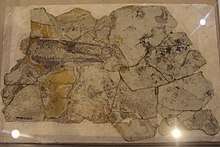
Ikrandraco avatar is based on IVPP V18199, a partial skeleton including the skull and jaws, several neck vertebrae, a partial sternal plate, parts of both wings, and part of a foot. A second specimen, IVPP 18406, has also been assigned to Ikrandraco; it consists of a skull and jaws and the first three neck vertebrae. Both specimens come from the Aptian-age Lower Cretaceous Jiufotang Formation of Liaoning, with an estimated date of 120 million years ago. The type species is I. avatar, a second reference to the movie Avatar. It was described in 2014 by Wang Xiaolin and colleagues.[1]
In 1869, Harry Govier Seeley named Ptenodactylus machaerorhynchus,[2] at the same time disclaiming the name which makes it invalid by modern standards. In 1870, Seeley had realised that the generic name Ptenodactylus had been preoccupied and renamed the species into Ornithocheirus machaerorhynchus.[3] The specific name means "sabre snout" in Greek. In 1914 Hooley renamed it into Lonchodectes machae[r]orhynchus.[4] Its holotype, CAMSM B54855, was near Cambridge found in a layer of the Cambridge Greensand dating from the Cenomanian but containing reworked fossils from the Albian. It consists of the rear end of a symphysis of the lower jaws.[5]
Also in 1869, Seeley informally named "Ptenodactylus microdon".[2] In 1870, he formally named it Ornithocheirus microdon, "small tooth",[3] Hooley (1914) transferred this species to Lonchodectes to form the new combination Lonchodectes microdon.[4] Its holotype, CAMSM B54486, has its provenance in the Cambridge Greensand and consists of the front of a snout. The type specimen of Ornithocheirus oweni Seeley 1870, CAMSM B 54439, was synonymized with microdon by Unwin (2001),[6] and Rodrigues & Kellner (2013) agreed with this synonymy.[5]
In his review of Lonchodectidae, Alexander Averianov assigned Lonchodraco machaerorhynchus to Ikrandraco, and also declared Lonchodraco microdon (including P. oweni) a junior synonym of machaerorhynchus.[7]
Description

Ikrandraco avatar is notable for having a very long, low skull (the height of the back of the skull, at the quadrates, is less than 19% the length of the skull), with a prominent blade-like crest on the underside of the lower jaw and no corresponding crest on the tip of the upper jaw, a crest combination not seen in other pterosaurs to date. The posterior edge of the crest also has a hook-like process. Each side of the upper jaw has at least 21 small cylindrical teeth, and each side of the lower jaw has at least 19. The skull of the type specimen is 286.5 millimetres (11.28 in) long, and the skull of the second specimen is at least 268.3 millimetres (10.56 in) long.[1]
Rodrigues & Kellner established four autapomorphies of Ikrandraco machaerorhynchus (then Lonchodraco). A deep crest is present at the underside of the lower jaws. To the rear, the profile of this crest turns upwards. Behind this crest a depression is present at the underside of the jaws. The midline groove at the top of the lower jaws symphysis is deep. Furthermore, there is a density of 4.5 teeth per three centimetres of jaw edge.[5]
Classification
Wang et al. performed a phylogenetic analysis including Ikrandraco and found it to be a basal pteranodontoid, more derived than Pteranodon but not as derived as the istiodactylids, anhanguerids, and other pteranodontoids.[1] The portion of their results dealing with Pteranodontoidea is shown below.
| Pteranodontoidea |
| ||||||||||||||||||||||||||||||||||||||||||||||||||||||||||||||||||
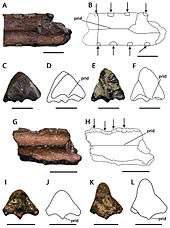
The cladogram below is a topology recovered by Pêgas et al. (2019). In the analyses, they recovered Ikrandraco as a member of the family Lonchodectidae (represented as Lonchodraconidae), and sister taxon of Lonchodraco.[8]
| Lanceodontia |
| |||||||||||||||||||||||||||||||||||||||||||||||||||||||||||||||||||||
Paleobiology
Wang et al. interpreted the crest as a possible adaptation for skim fishing, although they did not regard this as the animal's main method of foraging. The hook on the crest may have been an attachment point for a throat pouch for storing food, akin to a pelican. Ikrandraco was an approximate contemporary of distantly related anhanguerids Liaoningopterus gui and Guidraco venator, and all three are regarded as piscivores, but Ikrandraco differed from them in its much smaller and less robust teeth, indicating it had a different niche.[1]
References
- Xiaolin Wang; Taissa Rodrigues; Shunxing Jiang; Xin Cheng; Alexander W. A. Kellner (2014). "An Early Cretaceous pterosaur with an unusual mandibular crest from China and a potential novel feeding strategy". Scientific Reports. 4: Article number 6329. doi:10.1038/srep06329. PMC 5385874. PMID 25210867.
- Seeley, H.G., 1869, Index to the fossil remains of Aves, Ornithosauria, and Reptilia, from the Secondary System of Strata arranged in the Woodwardian Museum of the University of Cambridge. Deighton, Bell and Co., Cambridge, xxiii + 143 pp
- Seeley, H.G., 1870, The Ornithosauria: an elementary study of the bones of pterodactyls, made from fossil remains found in the Cambridge Upper Greensand, and arranged in the Woodwardian Museum of the University of Cambridge. Deighton, Bell, and Co., Cambridge, xii + 135 pp
- Hooley, R.W. (1914). "On the ornithosaurian genus Ornithocheirus, with a review of the specimens from the Cambridge Greensand in the Sedgwick Museum, Cambridge". Annals and Magazine of Natural History. 78: 529–557.
- Rodrigues, T.; Kellner, A. (2013). "Taxonomic review of the Ornithocheirus complex (Pterosauria) from the Cretaceous of England". ZooKeys. 308: 1–112. doi:10.3897/zookeys.308.5559. PMC 3689139. PMID 23794925.
- Unwin, D.M. (2001). "An overview of the pterosaur assemblage from the Cambridge Greensand (Cretaceous) of Eastern England". Mitteilungen aus dem Museum für Naturkunde in Berlin, Geowissenschaftliche Reihe. 4: 189–221. doi:10.1002/mmng.4860040112.
- Averianov, A.O. (2020). "Taxonomy of the Lonchodectidae (Pterosauria, Pterodactyloidea)". Proceedings of the Zoological Institute RAS. 324 (1): 41–55. doi:10.31610/trudyzin/2020.324.1.41.
- Rodrigo V. Pêgas, Borja Holgado & Maria Eduarda C. Leal (2019) On Targaryendraco wiedenrothi gen. nov. (Pterodactyloidea, Pteranodontoidea, Lanceodontia) and recognition of a new cosmopolitan lineage of Cretaceous toothed pterodactyloids, Historical Biology, doi:10.1080/08912963.2019.1690482

